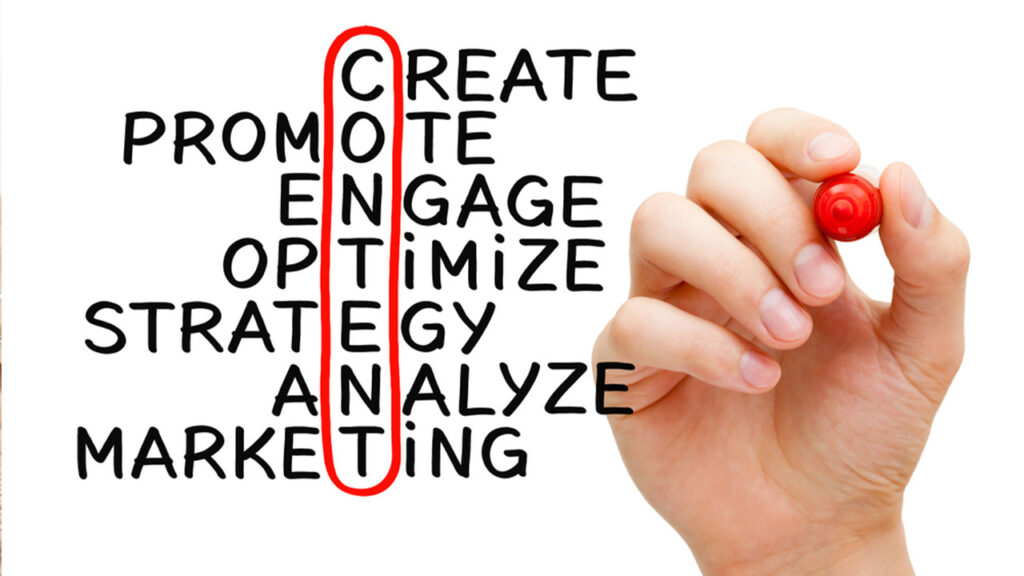Decoding the Essentials of a Successful Content Marketing Strategy
Brett Lewis
Content Marketing - December 19, 2023

If you’re searching for a proven framework to craft a compelling content marketing strategy, look no further. In this comprehensive guide, we dive straight into the actionable steps you need to take to align content with your business goals, connect with your target audience, and ultimately drive conversions. Expect to uncover insights on creating a content framework, understanding audience personas, competitor analysis, and the metrics that matter for a successful content campaign. Start building a content marketing strategy that delivers.
Key Takeaways
- A well-structured content marketing framework is key, requiring clear business objectives, alignment with goals, and understanding the role of content in meeting target audience needs.
- Content should be tailored to address each stage of the buyer’s journey and regularly audited for performance, with insights used to realign strategy and objectives.
- Competitor analysis, keyword research, strategic content calendar planning, and optimization of content distribution are vital activities for a successful content marketing strategy.
Crafting Your Content Marketing Framework

A robust framework serves as a guiding roadmap in the vast landscape of content marketing. It’s like a blueprint that outlines your business objectives, the role of your content, and the strategies you’ll employ to reach your goals. Remember, a well-crafted content marketing framework is the cornerstone of your marketing efforts, providing direction and focus to your content creation endeavors.
Additionally, it lays the groundwork for building brand recognition and establishing thought leadership. So, how do you create this framework? It all starts by defining your business objectives and understanding the role of your content. Let’s explore these aspects further.
Defining Business Objectives and Goals
Establishing clear and measurable objectives is a crucial step before embarking on content creation. These objectives form the backbone of your content marketing efforts, guiding you towards achieving your overall business goals. Start by positioning your brand in the market, building awareness, and captivating your target audience with valuable content. Remember, the success of your marketing efforts depends greatly on your ability to align your content marketing strategy with your business objectives.
Your content plays an instrumental role, from generating leads to bolstering your company’s reputation. Therefore, setting goals like long-term lead generation, influencing customer revenue, and significant audience engagement can help track your content’s impact on achieving your business objectives. However, it’s not enough to just set objectives. You need to identify relevant metrics and set specific targets to measure your content’s success.
Understanding Your Content’s Role
Understanding the role of your content follows the setting of your business objectives. Your content serves a purpose – it’s not just about filling up your blog or social media platforms with posts; it’s about providing your audience with relevant content that addresses their needs and interests.
The impact of your content can be seen in how it resonates with your audience. For instance, content that persuades and influences can help achieve business objectives by understanding your audience and tailoring messages to their values. On the other hand, content that entertains and engages can significantly enhance audience engagement and brand recognition. Therefore, understanding your content’s role can significantly influence your successful content marketing strategy.
Pinpointing Your Audience Persona

In content marketing, understanding your audience merits as much importance as having product knowledge. Why? Because your audience is at the heart of your content marketing strategy. It’s their needs, interests, and behaviors that determine the kind of content you create. And this is where audience personas come in.
An audience persona represents an ideal customer, semi-fictionally constructed based on market research and existing customer data. Creating an audience persona involves identifying your target audience, researching their demographics, and understanding their needs and preferences. Now, let’s delve deeper into gathering audience insights and mapping content to the buyer’s journey.
Gathering Audience Insights

To create content that resonates with your audience, you need to understand them first. This involves collecting demographic data, customer feedback, and using analytics tools to create detailed buyer personas. These insights can help you understand your customers’ behavior and preferences, enabling you to create a content marketing strategy that caters to their needs.
Tools like Google Analytics, customer surveys, and social media analytics can provide valuable insights into your audience’s behavior and preferences. By understanding who your customers are, what they want, and how they interact with your content, you can create a content marketing strategy that truly resonates with them. Such insights can be leveraged to optimize content for the audience’s preferences, thereby enhancing engagement and increasing the likelihood of conversion.
Mapping Content to the Buyer’s Journey
The concept of the buyer’s journey is fundamental in content marketing. It represents the process your customers go through from the moment they become aware of your brand to the point they make a purchase. This journey consists of three stages: awareness, consideration, and decision. Each stage plays a crucial role in the overall process..
To effectively guide your prospects through this journey, it’s crucial to develop content that corresponds to each stage. Here’s how your content should align with each stage:
- Awareness stage: Your content should educate your audience about their challenges and introduce potential solutions.
- Consideration stage: Your content should offer more in-depth information about your solutions.
- Decision stage: Your content should persuade your prospects to choose your solution over others.
By creating content that addresses each stage, you can effectively nurture your prospects and increase your chances of converting them into customers.
The Art of Competitor Analysis

Monitoring your competition holds significant importance in content marketing. Why? Because it gives you valuable insights into what works and what doesn’t, allowing you to make informed decisions about your own content marketing strategy. This is where competitor analysis comes in.
Competitor analysis entails the scrutiny of competitors’ content strategies to unveil potential opportunities and areas that need enhancement. It helps you understand what kind of content your competitors are creating, how they’re distributing it, and how it’s performing. Now, let’s delve deeper into how to identify key competitors and analyze their content tactics.
Identifying Key Competitors
The initial step in competitor analysis involves the identification of your key competitors. This involves determining who your direct and indirect competitors are and understanding their content marketing strategies. Once you’ve identified your competitors, you can start analyzing their content.
Evaluating your competitors’ content can provide valuable insights into what works and what doesn’t in your industry. For instance, analyzing your competitors’ top-performing content can reveal successful tactics that you can adopt, while their low-performing content can highlight areas to avoid or opportunities for you to do better.
Analyzing Competitor Content Tactics
Once your competitors are identified, the ensuing step involves analyzing their content tactics. This involves examining their content to understand what makes it successful and identify areas where you can do better. This process can provide you with valuable insights that you can use to refine your own content marketing strategy.
For instance, by analyzing your competitors’ content, you can identify the types of content they produce, the platforms they use for distribution, and the tactics they use to engage their audience. These insights can help you identify gaps in your own strategy and discover new opportunities for growth.
Crafting a Conversion-Centric Content Funnel

In content marketing, a conversion-centric content funnel emerges as a potent tool. It represents the journey your prospects take from the moment they first interact with your content to the point they convert into customers. This funnel is typically divided into three stages: the awareness stage, the consideration stage, and the decision stage.
To craft a conversion-centric content funnel, it’s necessary to develop content that navigates prospects through each funnel stage. This ensures that your prospects receive the right information at the right time, making it easier for them to make informed decisions and ultimately, convert. Let’s delve deeper into how to create content for each stage of the funnel.
Awareness Stage Content Creation
The awareness stage is the first stage of the content funnel. It’s where you capture your prospects’ attention and make them aware of the challenges they’re facing. During this stage, your content should provide general information about these challenges and introduce potential solutions.
Content creation for this stage necessitates an understanding of your audience’s challenges and producing content that caters to these issues. This could involve writing a blog post, creating videos, sharing infographics, or even utilizing user generated content that educate your audience about their challenges and how your product or service can solve them.
Decision Stage Conversion Strategies
The decision stage is the final stage of the content funnel. It’s where your prospects make the decision to purchase your product or service. During this stage, your content should provide all the information your prospects need to make an informed decision.
Creating content for this stage involves understanding your prospects’ concerns and creating content that addresses these concerns. This could involve creating product comparison charts, expert guides, or case studies that provide in-depth information about your product or service. By providing valuable information at this stage, you can guide your prospects towards making a purchase.
Conducting a Comprehensive Content Audit
In content marketing, a content audit entails:
- A thorough review of every piece of content on your website
- Evaluating the performance of your content
- Identifying gaps
- Aligning your content with your overall content marketing strategy.
Conducting a content audit can provide valuable insights into the effectiveness of your content marketing efforts, helping you identify areas for improvement and opportunities for growth. Now, let’s delve deeper into how to evaluate content performance and align your content with your strategy goals.
Evaluating Content Performance
A vital component of a content audit is the evaluation of your content’s performance. This involves measuring engagement and conversions for each piece of content to determine its effectiveness and identify areas for improvement.
Evaluating content performance involves tracking metrics such as:
- Likes
- Comments
- Shares
- Page views
- Unique visitors
These metrics can provide valuable insights into user interaction with your content and the resulting level of engagement. By understanding which pieces of content resonate with your audience, you can create a more effective content marketing strategy that truly caters to their needs.
Aligning Content with Strategy Goals
Following the evaluation of your content’s performance, the subsequent step involves aligning your content with your overarching content marketing objectives. This involves ensuring that your content supports your business objectives and contributes to your overall marketing strategy.
Aligning your content with your strategy goals involves defining your content marketing goals, selecting relevant metrics, and tracking and analyzing data. By aligning your content with your strategy goals, you can ensure that all your content marketing efforts contribute to achieving your business objectives.
Keyword Mastery for Content Impact
In content marketing, keywords are the gateway to visibility. The right keywords can help your content rank higher in search engine results, making it easier for your target audience to find your content. But mastering keywords is not just about finding the most popular search terms. It’s about understanding the language your audience uses and creating content that catifies to their needs and interests.
Mastering keywords necessitates comprehensive keyword research to pinpoint relevant keywords and search terms for your content. This can help improve your content’s visibility in search engines, attract more organic traffic, and drive conversions. Now, let’s delve deeper into how to discover keywords and integrate them into your content.
Tools for Keyword Discovery
Conducting keyword research is pivotal in discovering the appropriate keywords for your content. This involves using keyword research tools to identify relevant keywords and search terms for your content. These tools can provide valuable insights into your audience’s search behavior, helping you create content that truly resonates with them. Some popular keyword research tools include:
- Google Keyword Planner
- SEMrush
- Ahrefs
- Moz Keyword Explorer
- Ubersuggest
By utilizing these tools, you can optimize your content for search engines and increase your chances of ranking higher in search engine results pages.
Some of the most effective tools for keyword discovery include Google Keyword Planner, Moz Keyword Explorer, and Soovle. These tools can provide valuable insights into the search terms your audience uses, helping you create content that addresses their needs and preferences. By leveraging these tools, you can discover high-volume and relevant keywords that can improve your content’s visibility in search engines.
Integrating Keywords into Content
Following the discovery of the right keywords for your content, the ensuing step is their integration into your content. This involves incorporating your targeted keywords into your content in a way that improves its visibility in search engines and resonates with your audience.
Integrating keywords into your content involves using your keywords in your titles, headings, and meta descriptions. It also involves creating sentences that accurately describe your content and encourage searchers to click on your content. By integrating keywords into your content, you can improve its visibility in search engines and attract more organic traffic.
Strategic Content Calendar Planning
In content marketing, planning is paramount and a content calendar emerges as an indispensable tool for orchestrating your efforts. A content calendar can help you organize and schedule your content creation, ensuring consistency and efficiency in your content marketing efforts.
A content calendar provides a visual representation of your content strategy, allowing you to see what content is being published, when it’s being published, and where it’s being published. It can help you keep track of important dates and deadlines, ensure that your content is aligned with your marketing goals, and help you maintain consistency in your content creation.
Now, let’s delve deeper into how to prioritize content topics and implement a publishing schedule.
Prioritizing Content Topics
Content calendar planning indispensably involves prioritizing content topics. This involves determining the most important content topics based on audience needs, keyword research, and competitor analysis.
Prioritizing content topics involves understanding your audience and selecting topics that are relevant to their needs and interests. It also involves conducting keyword research to identify high-volume search terms that can improve your content’s visibility in search engines. By prioritizing the right content topics, you can create a content calendar that truly resonates with your audience and drives conversions.
Implementing a Publishing Schedule
Following the prioritization of your content topics, the subsequent step is the implementation of a publishing schedule. This involves scheduling your content creation and publication to ensure consistency and efficiency in your content marketing efforts.
Implementing a publishing schedule involves:
- Deciding when to publish your content
- How often to publish
- Where to publish
- Monitoring your content’s performance and making adjustments as needed
By implementing a publishing schedule, you can ensure that your content is published at the right time, in the right place, and in a way that resonates with your audience.
Optimizing Content Distribution and Repurposing
Optimization of content distribution and repurposing is integral to a successful content marketing strategy. This involves identifying the best channels for distributing your content and repurposing your existing content for maximum impact.
Optimizing content distribution involves selecting the most effective channels for distributing your content, based on audience preferences and content format. Repurposing content, on the other hand, involves updating and reusing your existing content to extend its lifespan and reach a wider audience. Now, let’s delve deeper into how to select distribution channels and maximize content lifespan.
Selecting Distribution Channels
Choosing appropriate distribution channels for your content is vital in amplifying its reach and impact. This involves identifying the channels where your audience spends most of their time and where your content is most likely to be seen and engaged with.
The selection of distribution channels should be based on your target audience, the type of content you’re distributing, and your overall marketing strategy. By choosing the right distribution channels, you can ensure that your content reaches the right audience at the right time, maximizing its impact and driving conversions.
Maximizing Content Lifespan
To extract more value from your content marketing endeavors, it’s effective to maximize the lifespan of your content. This involves repurposing and updating your existing content to extend its lifespan and reach a wider audience.
Maximizing content lifespan involves identifying your evergreen content, updating old content, and reusing various components of your content. By maximizing the lifespan of your content, you can ensure that your content continues to deliver value to your audience long after it was first published, driving ongoing engagement and conversions.
Measuring Content Marketing Effectiveness
The success of your content marketing strategy hinges on the measurement of your content marketing efforts’ effectiveness. This involves setting key performance indicators (KPIs) and utilizing analytics tools to track the success of your content marketing efforts.
Measuring content marketing effectiveness involves tracking metrics such as:
- Engagement
- Social media interest
- Brand visibility
- SEO ranking
- Backlinks
- Conversion rates
By measuring the effectiveness of your content marketing efforts, you can make data-driven decisions that improve your content marketing strategy and drive results.
Now, let’s delve deeper into how to set and track KPIs and utilize analytics tools.
Setting and Tracking KPIs
An essential aspect of measuring content marketing effectiveness is setting and tracking key performance indicators (KPIs). KPIs are measurable values that track the performance of your content marketing efforts, helping you understand what’s working and what’s not.
Setting and tracking KPIs involves selecting quantitative, relevant, and easy-to-calculate metrics that can effectively measure performance over time. Common KPIs include:
- Average session duration
- Referral traffic
- Social media likes
- Comments
By setting and tracking KPIs, you can ensure that all your content marketing efforts are contributing to achieving your business objectives.
Utilizing Analytics Tools
Another crucial aspect of measuring content marketing effectiveness involves the utilization of analytics tools. These tools can provide valuable insights into the performance of your content, helping you identify trends, understand user behavior, and make data-driven decisions. By examining content marketing examples, you can better understand the strategies that work best for your target audience.
Some of the most effective tools for measuring content marketing performance include HubSpot Marketing Analytics and Google Analytics. These tools can provide valuable insights into key metrics such as audience engagement, conversion rates, and return on investment (ROI). By leveraging these tools, you can track the success of your content marketing efforts and make data-driven decisions that improve your content marketing strategy.
Summary
In conclusion, crafting a successful content marketing strategy involves a series of interconnected steps, ranging from defining your business objectives and understanding your audience to conducting a comprehensive content audit and measuring the effectiveness of your efforts. By following the strategies and best practices outlined in this blog post, you can create a robust content marketing strategy that resonates with your audience, boosts your brand visibility, and drives conversions.
Frequently Asked Questions
What are content marketing strategies?
Content marketing strategies involve creating and sharing valuable, relevant content to attract and retain a specific audience, ultimately driving profitable customer action. This can include articles, videos, podcasts, and other media to establish expertise and brand awareness.
What are the 5 essential elements of a content marketing strategy?
A successful content marketing strategy should have five core elements for effectiveness.
What are the 5 C’s of content marketing?
The 5 C’s of content marketing are clarity, conciseness, compelling, credible, and call to action. These elements are essential for creating effective and engaging content.
What are the 7 steps of content marketing?
To develop a successful content marketing strategy, you should follow these 7 steps, including determining the purpose, understanding your audience, defining key performance measures, examining existing content, aligning content with audience questions, identifying distribution channels, and developing a content calendar. These steps will help create a comprehensive and effective content marketing plan.
Why is a content marketing framework important?
A content marketing framework is important because it serves as a roadmap for your marketing efforts, outlining objectives, the role of content, and the strategies to reach your goals, ultimately establishing brand recognition and thought leadership.
